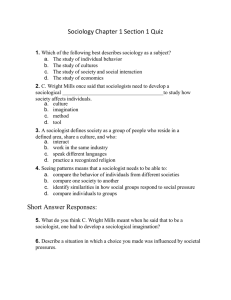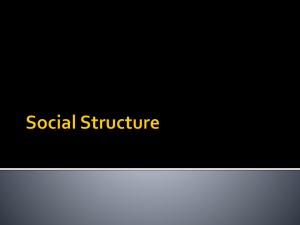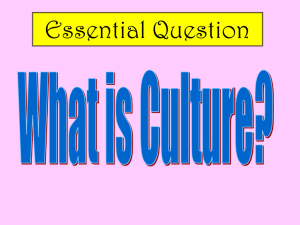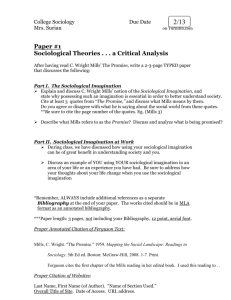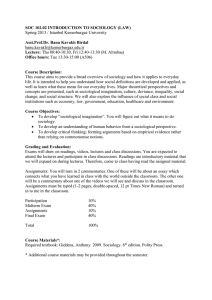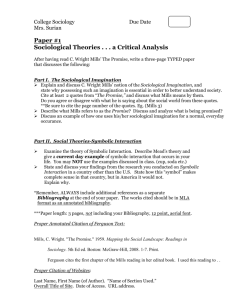Week Three (Jan. 26)
advertisement
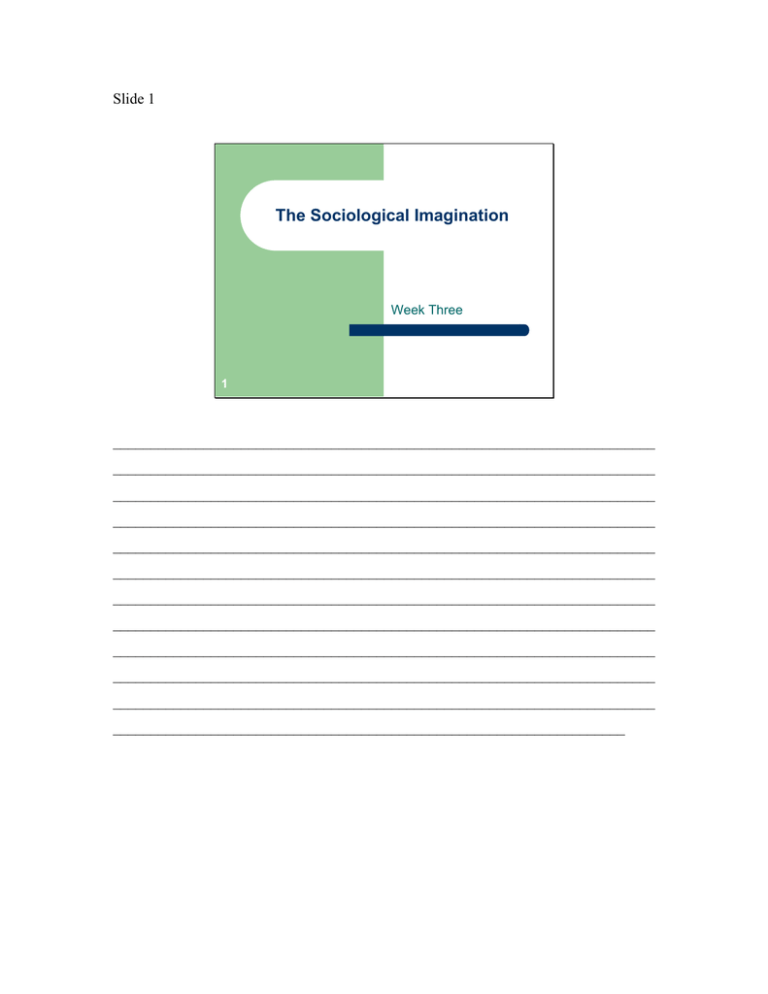
Slide 1 The Sociological Imagination Week Three 1 ________________________________________________________________________ ________________________________________________________________________ ________________________________________________________________________ ________________________________________________________________________ ________________________________________________________________________ ________________________________________________________________________ ________________________________________________________________________ ________________________________________________________________________ ________________________________________________________________________ ________________________________________________________________________ ________________________________________________________________________ ____________________________________________________________________ Slide 2 The Sociological Imagination, “The Promise” “Zeitgeist” circa 1959 - Fear of nuclear war Soviet and Chinese communist threats to the West (Cold War) - Growing power of the Military Industrial Complex - Growth of white collar work and routinized work (alienation) - Traditional values (e.g., relationship to work) are threatened - Memories are still fresh of Nazi Germany and its bureaucratic system of mass killing 2 ________________________________________________________________________ ________________________________________________________________________ ________________________________________________________________________ ________________________________________________________________________ ________________________________________________________________________ ________________________________________________________________________ ________________________________________________________________________ ________________________________________________________________________ ________________________________________________________________________ ________________________________________________________________________ ________________________________________________________________________ ____________________________________________________________________ Slide 3 Mills’ theme: entrapment of the individual, anxiety, and apathy Mills was concerned about how people are swept up by social changes. The rural person becomes a factory worker when society is industrialized. The craftsperson becomes a white-collar worker or clerk. Today: the welfare recipient becomes a low-wage worker. Yet, people don’t usually define their problems as related to social change or social forces. 3 ________________________________________________________________________ ________________________________________________________________________ ________________________________________________________________________ ________________________________________________________________________ ________________________________________________________________________ ________________________________________________________________________ ________________________________________________________________________ ________________________________________________________________________ ________________________________________________________________________ ________________________________________________________________________ ________________________________________________________________________ ____________________________________________________________________ Slide 4 Mills’ basic arguments Human beings cannot be understood apart from the social and historical structures that surround them. Modern life is dominated by growing bureacuracies and rapid technological change. Mills’ focus was on the rise of white-collar workers who are dependent on the bureaucracy. As more and more jobs are de-skilled and subject to strict bureaucratic regulation, people become alienated from their work and their humanity. 4 ________________________________________________________________________ ________________________________________________________________________ ________________________________________________________________________ ________________________________________________________________________ ________________________________________________________________________ ________________________________________________________________________ ________________________________________________________________________ ________________________________________________________________________ ________________________________________________________________________ ________________________________________________________________________ ________________________________________________________________________ ____________________________________________________________________ Slide 5 The Solution: The Sociological Imagination A quality of mind needed to understand the world One that enables people to make sense of what they are feeling Sociological imagination reduces “false consciousness” Enables us to see the connection between private troubles and public issues 5 ________________________________________________________________________ ________________________________________________________________________ ________________________________________________________________________ ________________________________________________________________________ ________________________________________________________________________ ________________________________________________________________________ ________________________________________________________________________ ________________________________________________________________________ ________________________________________________________________________ ________________________________________________________________________ ________________________________________________________________________ ____________________________________________________________________ Slide 6 Questions for Discussion With the passing of industrialization, we get “McJobs” – or low-paying service work. How does this type of historical change affect individual biographies? Try to do a Mills’ style analysis of the shift from industrial jobs/white collar jobs to service jobs. If you are more familiar with the local economy of Hawai‛i, try to think about this as an example. 6 ________________________________________________________________________ ________________________________________________________________________ ________________________________________________________________________ ________________________________________________________________________ ________________________________________________________________________ ________________________________________________________________________ ________________________________________________________________________ ________________________________________________________________________ ________________________________________________________________________ ________________________________________________________________________ ________________________________________________________________________ ____________________________________________________________________ Slide 7 Questions for Discussion Mills questions the “psychologizing” of everyday problems. What does he mean by this? To what extent is this a problem today? What are the implications of interpreting people’s issues as simply psychological in nature? Are there problems with interpreting people’s problems as simply social in nature? 7 ________________________________________________________________________ ________________________________________________________________________ ________________________________________________________________________ ________________________________________________________________________ ________________________________________________________________________ ________________________________________________________________________ ________________________________________________________________________ ________________________________________________________________________ ________________________________________________________________________ ________________________________________________________________________ ________________________________________________________________________ ____________________________________________________________________ Slide 8 Questions for Discussion Discuss how musical or other artists employ the “sociological imagination.” Cite examples from rap or other music, movies, or novels you’re familiar with. Give examples. What about the “ice” epidemic? Can we use the sociological imagination to analyze this problem? How? 8 ________________________________________________________________________ ________________________________________________________________________ ________________________________________________________________________ ________________________________________________________________________ ________________________________________________________________________ ________________________________________________________________________ ________________________________________________________________________ ________________________________________________________________________ ________________________________________________________________________ ________________________________________________________________________ ________________________________________________________________________ ____________________________________________________________________ Slide 9 Social Structure 9 Lindsey & Beach 2003 ________________________________________________________________________ ________________________________________________________________________ ________________________________________________________________________ ________________________________________________________________________ ________________________________________________________________________ ________________________________________________________________________ ________________________________________________________________________ ________________________________________________________________________ ________________________________________________________________________ ________________________________________________________________________ ________________________________________________________________________ ____________________________________________________________________ Slide 10 Social Structure – relatively stable patterns of social interaction that characterize human life Social structure involves three levels – – – 10 The individual level includes statuses and roles The group level includes primary and secondary groups The societal level contains formal organizations and institutions Lindsey & Beach 2003 ________________________________________________________________________ ________________________________________________________________________ ________________________________________________________________________ ________________________________________________________________________ ________________________________________________________________________ ________________________________________________________________________ ________________________________________________________________________ ________________________________________________________________________ ________________________________________________________________________ ________________________________________________________________________ ________________________________________________________________________ ____________________________________________________________________ Slide 11 Status and Role Status – the social position an individual occupies Individuals occupy various statuses – Student, worker, mother, friend, African-American – Not all of these statues are of equal rank or value (Status inconsistency) - Statuses provide clues as to who a person is and what can be expected of them – we learn how to interact with that person 11 ________________________________________________________________________ ________________________________________________________________________ ________________________________________________________________________ ________________________________________________________________________ ________________________________________________________________________ ________________________________________________________________________ ________________________________________________________________________ ________________________________________________________________________ ________________________________________________________________________ ________________________________________________________________________ ________________________________________________________________________ ____________________________________________________________________ Slide 12 Status Types Achieved vs. Ascribed Status Achieved status is a position resulting from a person’s own efforts or skills, e.g., education. Ascribed status is present at birth or assigned based on factors outside one’s control. Master status determines one’s identity – a status so powerful that other statuses may be ignored, e.g., President of France, convict, priest 12 ________________________________________________________________________ ________________________________________________________________________ ________________________________________________________________________ ________________________________________________________________________ ________________________________________________________________________ ________________________________________________________________________ ________________________________________________________________________ ________________________________________________________________________ ________________________________________________________________________ ________________________________________________________________________ ________________________________________________________________________ ____________________________________________________________________ Slide 13 Role Role * Involves the norms linked to a certain status * Expectations placed on a particular status * Roles guide us in decided what to do & what to expect. * Varied statuses mean varied roles – sometimes the expectations associated with these roles are in conflict. (Role Conflict) 13 ________________________________________________________________________ ________________________________________________________________________ ________________________________________________________________________ ________________________________________________________________________ ________________________________________________________________________ ________________________________________________________________________ ________________________________________________________________________ ________________________________________________________________________ ________________________________________________________________________ ________________________________________________________________________ ________________________________________________________________________ ____________________________________________________________________ Slide 14 Social Groups – two or more persons; regular interaction; sense of solidarity or group identity Primary groups – – – 14 Small, rather permanent group, typically emotionally close and personal Shared activities and time Important in shaping identity Secondary groups – – – Usually larger groups; impersonal; nonemotional or neutral feelings Has a specific activity or goal Endures over time but membership changes Lindsey & Beach 2003 ________________________________________________________________________ ________________________________________________________________________ ________________________________________________________________________ ________________________________________________________________________ ________________________________________________________________________ ________________________________________________________________________ ________________________________________________________________________ ________________________________________________________________________ ________________________________________________________________________ ________________________________________________________________________ ________________________________________________________________________ ____________________________________________________________________ Slide 15 The Continuum from Primary to Secondary Groups 15 Lindsey & Beach 2003 ________________________________________________________________________ ________________________________________________________________________ ________________________________________________________________________ ________________________________________________________________________ ________________________________________________________________________ ________________________________________________________________________ ________________________________________________________________________ ________________________________________________________________________ ________________________________________________________________________ ________________________________________________________________________ ________________________________________________________________________ ____________________________________________________________________ Slide 16 Formal Organizations and Institutions Formal Organizations – Large secondary group designed for specific tasks with complex divisions of labor Institutions – – Predictable established ways to provide for one or more of society’s basic needs Examples: Family Religion Economy Polity Education 16 ________________________________________________________________________ ________________________________________________________________________ ________________________________________________________________________ ________________________________________________________________________ ________________________________________________________________________ ________________________________________________________________________ ________________________________________________________________________ ________________________________________________________________________ ________________________________________________________________________ ________________________________________________________________________ ________________________________________________________________________ ____________________________________________________________________ Slide 17 The Evolution of Society: Emile Durkheim (1858-1917) Notes the increasing movement of human societies from simple to complex Interested in understanding the maintenance of social cohesion in light of the growing complexity of society Identifies two systems of social organization: – Mechanical and Organic Solidarity 17 ________________________________________________________________________ ________________________________________________________________________ ________________________________________________________________________ ________________________________________________________________________ ________________________________________________________________________ ________________________________________________________________________ ________________________________________________________________________ ________________________________________________________________________ ________________________________________________________________________ ________________________________________________________________________ ________________________________________________________________________ ____________________________________________________________________ Slide 18 Mechanical and Organic Solidarity Mechanical Solidarity – – – – Characterizes most of human history Small in scale Economic roles involve multi-tasking Cohesion maintained by similar, small group activities Organic Solidarity – – – Economic complexity & larger size Division of Labor – Increased Specialization Cohesion maintained through institutional interdependence 18 ________________________________________________________________________ ________________________________________________________________________ ________________________________________________________________________ ________________________________________________________________________ ________________________________________________________________________ ________________________________________________________________________ ________________________________________________________________________ ________________________________________________________________________ ________________________________________________________________________ ________________________________________________________________________ ________________________________________________________________________ ____________________________________________________________________ Slide 19 The Evolution of Society: Ferdinand Tönnies (1855-1936) Also examines the consequences of societal change Interested in the reshaping of human associations through the modernization of societies Identifies two sets of human associations – Gemeinschaft and Gesellschaft 19 ________________________________________________________________________ ________________________________________________________________________ ________________________________________________________________________ ________________________________________________________________________ ________________________________________________________________________ ________________________________________________________________________ ________________________________________________________________________ ________________________________________________________________________ ________________________________________________________________________ ________________________________________________________________________ ________________________________________________________________________ ____________________________________________________________________ Slide 20 Gemeinschaft & Gesellschaft 20 Gemeinschaft - natural will (relations are ends in themselves) - small, rural groups - custom & tradition important - relations are personal and enduring - kinship and ascribed status - informal social control (gossip) - community important Gesellschaft - rational will (relations are a means to an end) - urban - commercial activities characterize interactions - impersonal relationships - achieved status - temporary relationships - formal rules - individual important Lindsey & Beach 2003 ________________________________________________________________________ ________________________________________________________________________ ________________________________________________________________________ ________________________________________________________________________ ________________________________________________________________________ ________________________________________________________________________ ________________________________________________________________________ ________________________________________________________________________ ________________________________________________________________________ ________________________________________________________________________ ________________________________________________________________________ ____________________________________________________________________ Slide 21 Gerhard and Jean Lenski’s: Stages off Sociocultural Evolution Economic Basis of Society First appeared Economic Basis Extent of Structured Inequality Hunting and Gathering Hunting wild game – gathering wild plants (most of human history) 250,000 years ago (or more) Hunting, gathering of plants & fishing Egalitarian except some age and gender distinctions Horticultural Gardens tended with tools 12,000 to 10,00 years ago Gardens tended with hand tools Substantial inequality emerges Pastoral/ Agrarian Fields plowed by draft animals 12,000 to 6,000 years ago Domestication Draft animals Great extremes of wealth and poverty Industrial Factories powered by non animate energy sources 200 years ago Factories powered by machines & paid labor Reduced inequality; social classes; substantial mobility Postindustrial Service and information Emerging Services & information, computers Too early to determine 21 ________________________________________________________________________ ________________________________________________________________________ ________________________________________________________________________ ________________________________________________________________________ ________________________________________________________________________ ________________________________________________________________________ ________________________________________________________________________ ________________________________________________________________________ ________________________________________________________________________ ________________________________________________________________________ ________________________________________________________________________ ____________________________________________________________________ Slide 22 Gerhard and Jean Lenski’s Stages of Sociocultural Evolution The Lenski’s theory may be wrong about reduced inequality associated with modern and post-modern eras. While some forms of inequality are being reduced in industrialized societies, global inequality is increasing between the nations of the developed world and those of the undeveloped world. 22 ________________________________________________________________________ ________________________________________________________________________ ________________________________________________________________________ ________________________________________________________________________ ________________________________________________________________________ ________________________________________________________________________ ________________________________________________________________________ ________________________________________________________________________ ________________________________________________________________________ ________________________________________________________________________ ________________________________________________________________________ ____________________________________________________________________ Slide 23 Bur eaucr acy Max Weber – As society becomes more complex it needs a more rational based system of organization to operate efficiently – Bureaucracy Division of Labor Written Regulations Documentation of Activities A Hierarchy of Authority Mobility tied to Objective Qualifications Impartiality 23 ________________________________________________________________________ ________________________________________________________________________ ________________________________________________________________________ ________________________________________________________________________ ________________________________________________________________________ ________________________________________________________________________ ________________________________________________________________________ ________________________________________________________________________ ________________________________________________________________________ ________________________________________________________________________ ________________________________________________________________________ ____________________________________________________________________ Slide 24 Bureaucracies – A warning! – Bureaucracies will proliferate and dominate modern society – The continual movement toward rationalization will generate social systems that are fundamentally dehumanizing. 24 ________________________________________________________________________ ________________________________________________________________________ ________________________________________________________________________ ________________________________________________________________________ ________________________________________________________________________ ________________________________________________________________________ ________________________________________________________________________ ________________________________________________________________________ ________________________________________________________________________ ________________________________________________________________________ ________________________________________________________________________ ____________________________________________________________________ Slide 25 Bureaucratic Blues (Dysfunctions) Communication problems Trained incapacity Bureaucratic personalities Bureaucratic ritualism Goal displacement Parkinson’s law (“look busy”!) Peter Principle & hierarchies Oligarchy – concentration of power 25 ________________________________________________________________________ ________________________________________________________________________ ________________________________________________________________________ ________________________________________________________________________ ________________________________________________________________________ ________________________________________________________________________ ________________________________________________________________________ ________________________________________________________________________ ________________________________________________________________________ ________________________________________________________________________ ________________________________________________________________________ ____________________________________________________________________ Slide 26 Taming the Bureaucracy Scientific management (Taylorism) Human relations – more equality Collectivities – power is distributed, decisions based on some consensus Japanese model – lifetime employment, consensus model, holistic training Flexible bureaucracies – shared responsibility, minimal hierarchy 26 ________________________________________________________________________ ________________________________________________________________________ ________________________________________________________________________ ________________________________________________________________________ ________________________________________________________________________ ________________________________________________________________________ ________________________________________________________________________ ________________________________________________________________________ ________________________________________________________________________ ________________________________________________________________________ ________________________________________________________________________ ____________________________________________________________________

